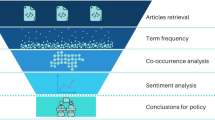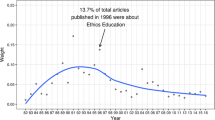Abstract
To foresee the advent of new technologies and their socio-economic impact is a necessity for academia, governments and private enterprises as well. In the future studies, the identification of future signal is one of the renowned techniques for analysis of trends, emerging issue, and gaining future insights. In the Big Data era, recent scholars have proposed using a text mining procedure focusing upon web data such as new social media and academic papers. However, the detection of future signals is still under a developing area of research, and there is much to improve existing methodology as well as developing theoretical foundations. The present study reviews previous literature on identifying emerging issue based on the weak signal detection approach. Then the authors proposed a revised framework that incorporate quantitative and qualitative text mining for assessing the strength of future signals. The authors applied the framework to the case study on the ethical issues of artificial intelligence (hereafter AI). From EBSCO host database, the authors collected text data covering the ethical issues in AI and conducted text mining analysis. Results reveal that emerging ethical issues can be classified as strong signal, weak signal, well-known but not so strong signal, and latent signal. The revised methodology will be able to provide insights for government and business stakeholders by identifying the future signals and their meanings in various fields.







Similar content being viewed by others
Notes
In the literature the term ‘signal’ and ‘sign’ were used interchangeably, we consider Hiltunen (2008)’s weak sign to be a synonym with weak signal for preventing confusion.
Sam Byford, ‘Google’s AlphaGo AI beats Lee Se-dol again to wi Go series 4-1’ on The Verge (15 March 2016), http://www.theverge.com/2016/3/15/11213518/alphago-deepmind-go-match-5-result.
Lilian Kim, ‘Parents Upset after Palo Alto Security Robot Injures Child’ on ABC7 (11 July 2016), http://abc7.com/news/parents-upset-after-norcal-security-robot-injures-child/1424537/.
Samuel Gibbs, ‘Microsoft’s racist chatbot returns with drug-smoking Twitter meltdown’ on The Guardian (30 March 2016), https://www.theguardian.com/technology/2016/mar/30/microsoft-racist-sexist-chatbot-twitter-drugs.
Neal Boudette, ‘Tesla’s Self-Driving System Cleared in Deadly Crash’ on The New York Times (19 January 2017), https://www.nytimes.com/2017/01/19/business/tesla-model-s-autopilot-fatal-crash.html?_r=0.
Executive Office of the President of the United States, Artificial Intelligence, Automation and the Economy (Executive Office of the President, 2016), https://www.whitehouse.gov/sites/whitehouse.gov/files/images/EMBARGOED%20AI%20Economy%20Report.pdf.
Alex Hern, ‘give Robots Personhood Status, EU Committee Argues’ on The Guardian (12 January 2017), https://www.theguardian.com/technology/2017/jan/12/give-robots-personhood-status-eu-committee-argues.
IEEE, ‘Robot Ethics’ on IEEE (2017), http://www.ieee-ras.org/robot-ethics.
Peer reviewers include participants of WATEF International Conference 2016: DISC (data, innovation, social, and conversion).
References
Ansoff, H.I.: Managing strategic surprise by response to weak signals. Calif. Manag. Rev. 18(2), 21–33 (1975)
Carley, K., Kaufer, D.: Semantic connectivity: an approach for analyzing symbols in semantic networks. Commun. Theory 3(3), 183–213 (1993)
Cho, S.E., Choi, M.G., Park, H.W.: Government-civic group conflicts and communication strategies: a text analysis of TV debates on Korea’s import of U.S. beef. J. Contemp. East. Asia 11(1), 1–20 (2012)
Choi, S., Park, H.W.: Networking interest and networked structure: a quantitative analysis of Twitter data. Soc. Sci. Comput. Rev. 33(2), 145–162 (2015)
Choo, C.W.: The art of scanning the environment. Bull. Am. Soc. Inf. Sci. Technol. 25(3), 21–24 (1999)
Choo, C.W., Auster, E.: Environmental scanning: acquisition and use of information by managers. Ann. Rev. Inf. Sci. Technol. 28, 279–314 (1993)
Coffman, B.: Weak signal research. Part I. Introduction, MG Taylor Corporation (1997)
Dator, J. A.: Advancing futures: Futures studies in higher education. Greenwood Publishing Group (2002)
Danowski, J.A.: WORDij 3.0 [Computer Program]. University of Illinois at Chicago, Chicago (2010)
Doerfel, M.L.: What constitutes semantic network analysis? A comparison of research and methodologies. Connections 21(2), 16–26 (1998)
Doerfel, M. L., Barnett, G. A.: A Semantic Network Analysis of the International Communication Association. Human Communication Research. 25(4), 589–603 (1999)
Girvan, M., Newman, M.E.: Community structure in social and biological networks. Proc. Natl. Acad. Sci. 99(12), 7821–7826 (2002)
Hellsten, I., Dawson, J., Leydesdorff, L.: Implicit media frames: automated analysis of public debate on artificial sweeteners. Public Underst. Sci. 19(5), 590–608 (2010)
Hiltunen, E.: Was it a wild card or just our blindness to gradual change. J. Futures Stud. 11(2), 61–74 (2006)
Hiltunen, E.: The future sign and its three dimensions. Futures 40(3), 247–260 (2008)
Hong, S.W., Kim, Y.E., Bae, K.J., Park, Y.W., Park, J.K.: Development of analysis model for R&D environment change in search of the weak signal. J. Korea Technol. Innov. Soc. 12(1), 189–211 (2009)
Hong, Y.J., Shin, D., Kim, J.H.: High/low reputation companies’ dialogic communication activities and semantic networks on Facebook: a comparative study. Technol. Forecast. Soc. Change 110, 78–92 (2016)
Hsu, C.L., Park, S.J., Park, H.W.: Political discourse among key Twitter users: the case of Sejong City in South Korea. J. Contemp. East. Asia 12(1), 65–79 (2013)
Julien, P.A., Andriambeloson, E., Ramangalahy, C.: Networks, weak signals and technological innovations among SMEs in the land-based transportation equipment sector. Entrep. Reg. Dev. 16(4), 251–269 (2004)
Jung, K., Valero, J.N.: Assessing the evolutionary structure of homeless network: social media use, keywords, and influential stakeholders. Technol. Forecast. Soc. Change 110, 51–60 (2016)
Kamppinen, M., Kuusi, O., Soderlund, S.: Tulevaisuudentutkimus Perusteet ja Sovellukset (Futures Studies, Foundations and Directions). Suomalaisen Kirjallisuuden Seura, Helsinki (2002)
Kuosa, T.: Futures signals sense-making framework (FSSF): a start-up tool to analyse and categorise weak signals, wild cards, drivers, trends and other types of information. Futures 42(1), 42–48 (2010)
Kuusi, O., Hiltunen, E.: The signification process of the future sign. J. Futures Stud. 16(1), 47–66 (2011)
Lee, Y.-J., Lee, J.-H., Ham, K.S.: Balancing efficiency and flexibility in software project: the role of team collective improvisation, behavioral integration, and member diversity. J. Contemp. East. Asia 16(1), 22–45 (2017)
Maurits Butter, M.L., Cagnin, C., Carabias, V., Könnölä, T., van Rij, V., Klerx, J., Schape Rinkel, P., Amanatidou, E., Saritas, O., Harper, J.C., Pace, L.: Scanning for early recognition of emerging issues; dealing with the unexpected, an operational framework for the identification and assessment of new future developments. Workshop paper: SESTI methodology, workshop 26 October 2010
Murtagh, F., Pianosi, M., Bull, R.: Semantic mapping of discourse and activity, using Habermas’s theory of communicative action to analyze process. Qual. Quant. 50(4), 1675–1694 (2016)
Ponomareva, J., Sokolova, A.: The identification of weak signals and wild cards in foresight methodology: stages and methods (No. WP BRP 46/STI/2015). National Research University Higher School of Economics (2015)
Pratama, A.B.: Online-based local government image typology: a case study on jakarta provincial government official YouTube videos. J. Contemp. East. Asia 16(1), 1–21 (2017)
Smith, M.: Catalyzing social media scholarship with open tools and data. J. Contemp. East. Asia 14(2), 87–96 (2015)
Stek, P.E., van Geenhuizen, M.S.: The influence of international research interaction on national innovation performance: a bibliometric approach. Technol. Forecast. Soc. Change 110, 61–70 (2016)
Sudhahar, S., Veltri, G., Christianini, N.: Automated analysis of the US presidential elections using Big Data and network analysis. Big Data Soc. 2(1), 1–28 (2015)
Thorleuchter, D., Van den Poel, D.: Technology classification with latent semantic indexing. Expert Syst. Appl. 40(5), 1786–1795 (2013a)
Thorleuchter, D., Van den Poel, D.: Protecting research and technology from espionage. Expert Syst. Appl. (2013b). doi:10.1016/j.eswa.2012.12.051
Thorleuchter, D., Van den Poel, D.: Weak signal identification with semantic web mining. Expert Syst. Appl. 40(12), 4978–4985 (2013c)
Thorleuchter, D., Van den Poel, D.: Idea mining for web-based weak signal detection. Futures 66, 25–34 (2015)
Thorleuchter, D., Scheja, T., Van den Poel, D.: Semantic weak signal tracing. Expert Syst. Appl. 41(11), 5009–5016 (2014)
Wang, W., Rada, R.: Structured hypertext with domain semantics. ACM Trans. Inf. Syst. 16(4), 372–412 (1998)
Wasserman, S., Faust, K.: Social Network Analysis: Methods and Applications. Cambridge University Press, Cambridge (1994)
Yoo, S.H., Park, H.W., Kim, K.H.: A study on exploring weak signals of technology innovation using informetrics. J. Technol. Innov. 17(2), 109–130 (2009)
Yoon, J.: Detecting weak signals for long-term business opportunities using text mining of Web news. Expert Syst. Appl. 39(16), 12543–12550 (2012)
Author information
Authors and Affiliations
Corresponding author
Appendix
Rights and permissions
About this article
Cite this article
Lee, YJ., Park, JY. Identification of future signal based on the quantitative and qualitative text mining: a case study on ethical issues in artificial intelligence. Qual Quant 52, 653–667 (2018). https://doi.org/10.1007/s11135-017-0582-8
Published:
Issue Date:
DOI: https://doi.org/10.1007/s11135-017-0582-8




